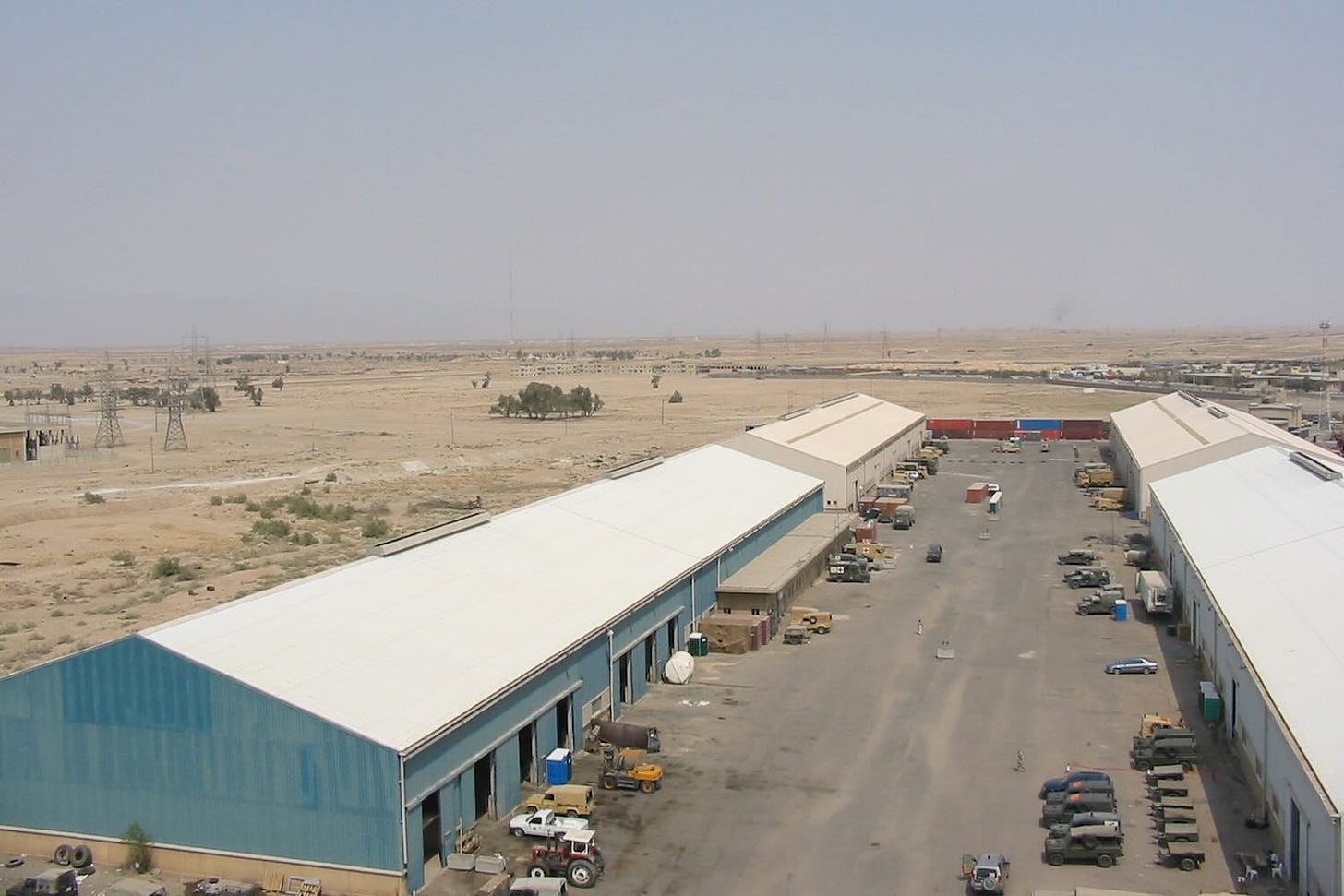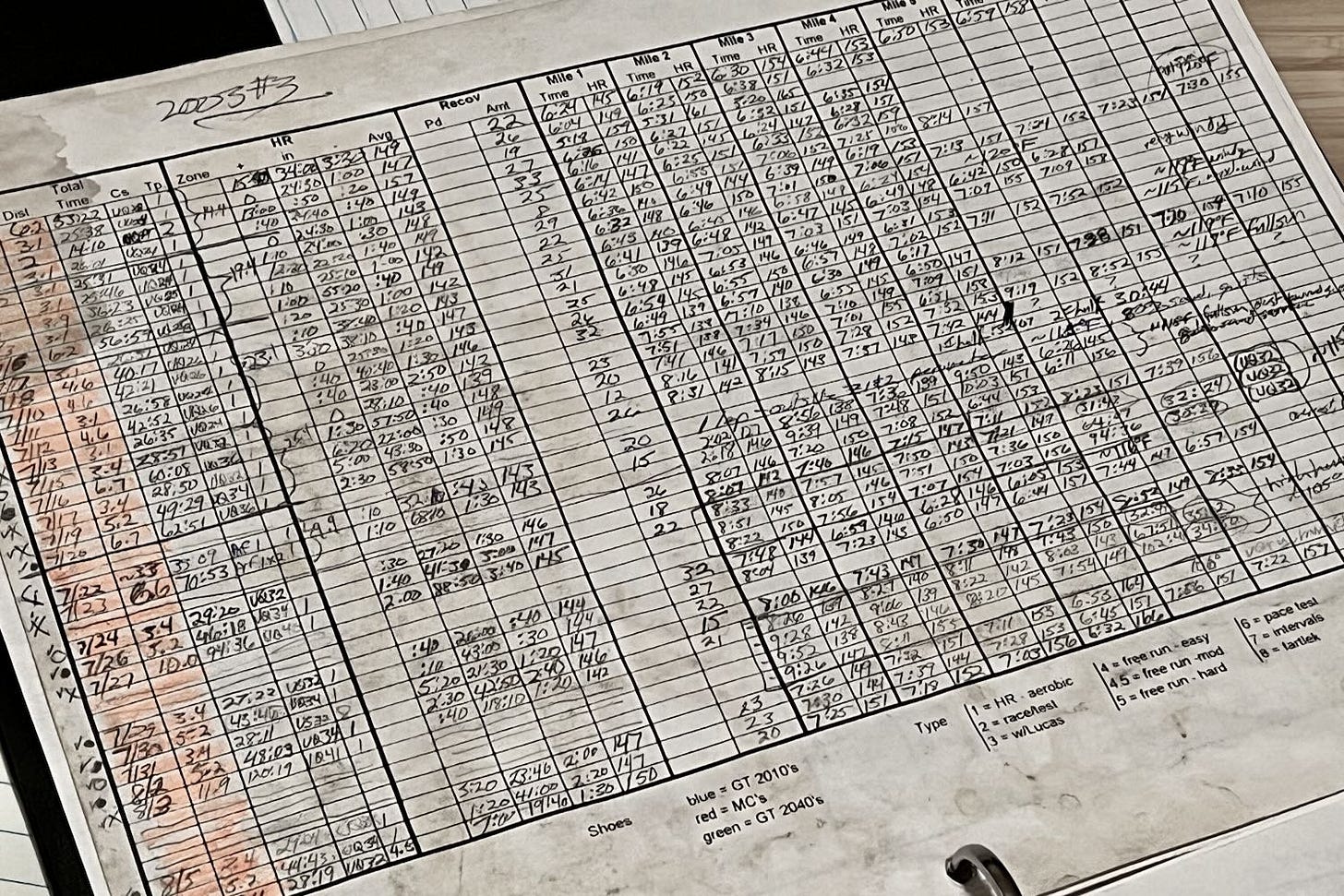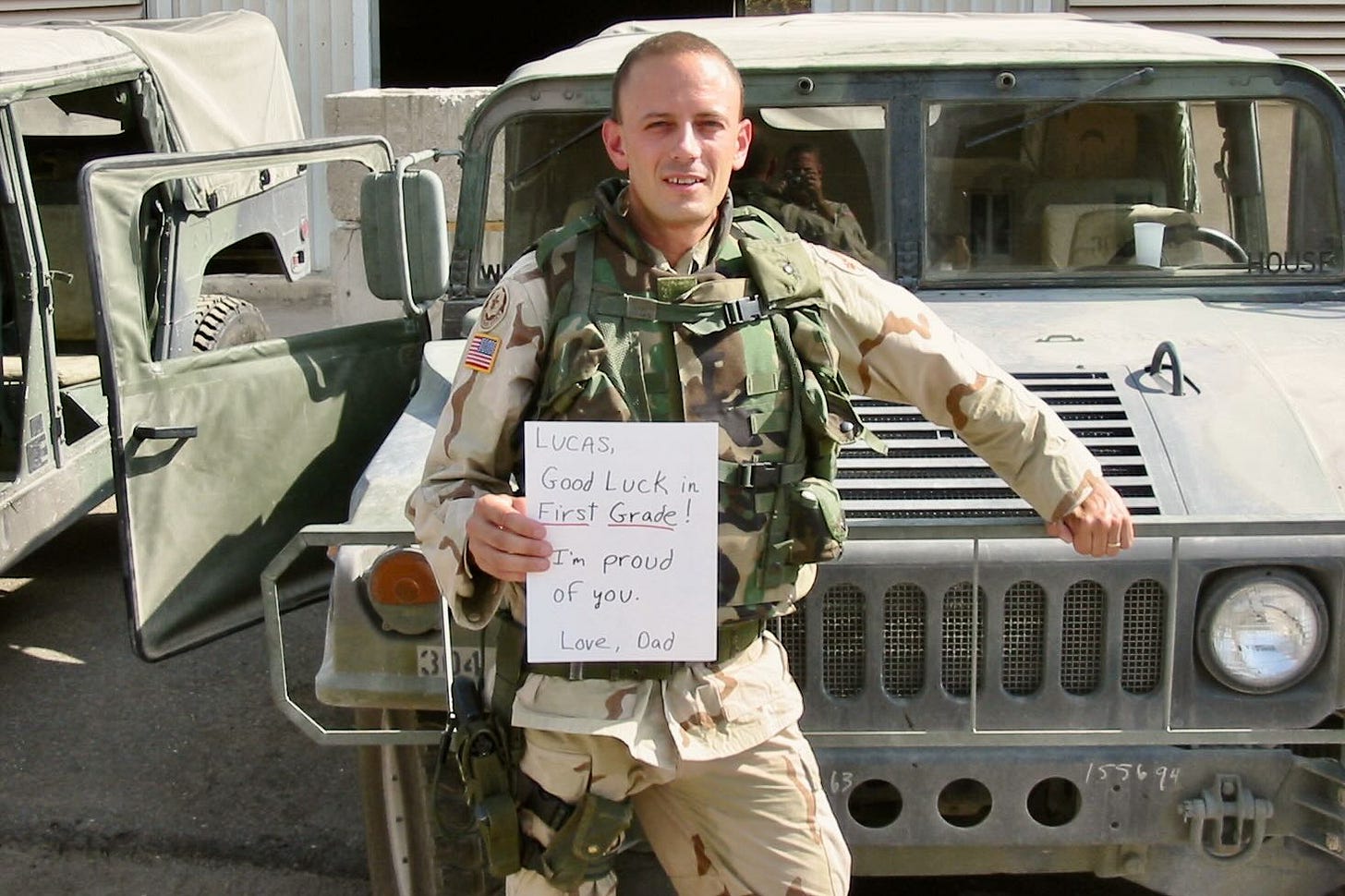Throughlines (part 1)
War and marathons
Welcome to everyone who subscribed after my last post:
There were a lot of you — thanks!
That post drew more attention than anything I’ve published here before, and I’m heartened by the fact that so many people shared concern about the situation and were willing to speak up about it. In the interest of fairness, I want to acknowledge that UTMB gave a prompt and professional reply to our organization’s request to have our race (Eastern States 100) removed as an Index Race, and they sent this link to their “Open Letter to the Trail Running Community”. I’m not personally swayed by this, and our response was not based on the technicalities of the situation, but I appreciate that they at least acknowledge the issue.
Now, on to today’s topic…
Throughlines
In the first of my 20-years-ago posts about my second tour of duty in Iraq (Change of Mission (Iraq, 2003)), I said that running can be a test in itself, an elective “hard thing”, but it can also be a way to get through hard things — an anchor, or a refuge, a consistency that’s there regardless of pressures and chaos and deprivation.
That’s true, but there can be more to it. The real power, the thing that takes you beyond just temporary refuge, is continuity, the fact of a throughline that is solidly anchored in your past, and that you can see leading clearly into your future, (even if that line is the only thing you can see). The strength of it depends on the strength of the anchors, and how tightly you grab hold of that line and follow it.
I think it was during this deployment that I first thought of it this way. Here’s a journal entry from June 29, 2003:
There really are these two things that ground me, that have been pieces of constancy and relative stability through the past several years — writing and running. For the past 5–6 years, I’ve been steadily doing both, regardless of what else is happening [and there was a lot happening], where I’m living, what I’m doing, what the external factors are.
Looking back now at my running (and writing) through those days, I can see how much I needed that, how preserving — and formative — it was. In particular, I can see that my commitment to a nascent marathon streak helped set my anchors in stone and gave me the throughline that, decades later, I still grasp tightly.
Finally on mission
After months of mobilization training, we finally arrived in southern Iraq in April, 2003 (30 days after the start of the war).
Our mission was tactical civil-military operations and support to civil administration in southern Basrah Province, specifically in the towns of Umm Qasr, Safwan, and Khor Zubayr, and at the Port of Umm Qasr (which is also where we lived, on a British logistics base located on the port).
There are many stories to tell about the work we did there, but those are for a different post (or maybe a book).
This one is about running…
When we arrived to Umm Qasr, we didn’t know how long we’d be there. The optimistic scenarios had us home by autumn, but other versions said we’d be there until sometime in 2004.
At this point, my running was only a tenuous throughline, but I was already starting to identify as “a runner”, and in 2002 I’d managed my 5th marathon in as many years despite being mobilized then, too. (That one was easier to manage — I was deployed to Germany for work in the Balkans, and I lived in Stuttgart.)
So, from the start of this deployment I was scheming about how to get my 2003 marathon in — either by getting home in time to run it in the fall, or by doing one here (soldiers were already staging marathons in Afghanistan… surely we could do the same in Iraq or Kuwait).
So I embraced the heat, I did my job, and while off-duty, I ran.
A long, hot summer (and lots of loops)
Initially, the threat level was low, and the entire port facility (over a mile and half end-to-end) was guarded and secure, so there was room for relatively large loops and lots of exploring.
The weather was warm from the beginning, and by May it was consistently over 100F in the daytime, but it didn’t get really hot until June. A sampling of journal entries tell the tale (both the good and the bad) of heat acclimation:
June 1, 2003: I can’t believe how low my heart rate is staying lately when I’m running. It is weird, and I thought maybe the machine was misreading it, but I’ve done spot checks and it is accurate — and my heart rate is 5 or 10 beats lower than I would expect it to be. Maybe it’s a short-term fluke, or maybe I just all of the sudden got healthier — from the fresh Iraqi air or something...
June 8, 2003: I would like to think that today was just one of those periodic flukes of a bad day for me for running, and that well may be the case. But it also might be the case that I got cocky about my abilities and didn’t give proper respect to the high temperature. I’ve been doing fine lately with my afternoon/evening runs at ~105°F, and so I wanted to challenge myself, so I decided to do a double lap, which would have been 7.4 miles, and I waited for the hottest part of the day to do it. It was at least 113°F, and maybe warmer, and it was full sun, and I wore my 100-ounce Camelback which weighs several pounds (for the first time) and I set out with good intentions. But it quickly became evident that it would be a struggle. My heart rate shot up and stayed up early on, and I couldn’t keep it in the zone for anything without walking — which I eventually did.
… Was it the extra 5 degrees? The extra weight? Maybe just a bad day? I don’t know for sure, and it is probably a combination of all of that. I just have to take it in stride and learn from it and not be so cocky about hot-weather running, and most of all continue to be careful, without taking the easy way out.
June 10, 2003: Well, I feel better about myself now. I went out and ran today when it was at least 112F, and I ran 5.6 miles, and it was fine. So it makes it seem more and more like the bad run on Sunday was just a bad day. I didn’t set any records, but I did finish strong, and my heart rate stayed down, and I felt fine. And I will do a good week of running — shoot for maybe 27 miles total. I think that level will be very sustainable. … Then I can start to add a long run each week once I have a date in mind for a marathon.
By mid-June, the days of free-ranging the port were pretty much over. Much of the port had been opened, the security situation was beginning to fray, and the only consistently “safe” running was within the confines of the logistics compound we lived in — a set of five large warehouses within a perimeter wall of shipping containers topped with barbed wire. I was reduced to endless looping in the space between the buildings and the wall: less than 0.8 miles per lap, four loops for a 5k.
If you’re curious, here’s that route today on Strava: UQ compound loop

Of course there was no Strava back then, and I didn’t get my first GPS watch until later in the tour, so knowing precise distances involved careful map measurement and a systematic approach…
I logged hundreds of laps of that nasty little compound, the broken vehicles and oil-soaked sand, and I kind of hated it. But in another way the hypnotic sameness of it, over and over, was soothing. As the temperature climbed and the mission dragged on, it helped keep me sane.
It also made me stronger.
Two months later…
I hate to brag, but… Wednesday was the hottest day we’ve had so far, and I waited until mid-afternoon when it peaked to go for my run. I already had a run at 120F, but now I’ve logged mileage at 123F — how many people can say they’ve done that?
We were in Umm Qasr yesterday and sat down on the porch of a building in the market to talk with some people. LTC Williams and I sat there for about 20 minutes, and when we got up, the people were laughing — the plastic chairs we’d been sitting on were soaked, and there was a 1.5-foot diameter puddle of sweat on the floor underneath each of our chairs, just like we had pissed ourselves. Another very humid day, and in full battle gear, it gets hot. (The vest itself weighs 23 pounds with the new ceramic plates loaded in it.)
—from my letter to Renee, August 10, 2003 (Sunday)

EOM date, and a plan: Philadelphia
By mid-August, we finally had a solid date for End of Mission: August 31, and it looked like we were on track to be home by October. So I did my research, picked the perfect welcome home marathon (our unit was from Philadelphia), and I started recruiting other runners. Here’s the “press release” I sent to the brigade:
PRESS RELEASE
22 August 2003
---For Immediate Release and Widest Dissemination to 304th Civil Affairs Brigade---
2/304th (PROV) leads the way (again)
The first in, last out, Fatwa-be-damned soldiers of TF Eagle are once again leading the 304th Civil Affairs Brigade into battle. This time the stakes are lower, but the intensity of the challenge is not. The battlefield is 26.2 miles of Philadelphia asphalt — the 10th annual running of the Philadelphia Marathon on Sunday, 23 Nov 03.
The list of participants is a leadership Who’s Who for the unit:
Eagle 6 – LTC Nick “Maverick” Roper
Eagle Red 6 – LTC Pete “Darwin” Goebel
Eagle White 6 – LTC Jeff “Jesus” Williams
Eagle Blue 6 – LTC Jules “The Count” Oroszvary
Eagle 5 – MAJ Jeff “Duke” Calvert
Eagle 7 – SFC Albert “Pandemonium” Pando
A Challenge Issued
These intrepid soldiers enthusiastically invite (and challenge) the leadership of the Brigade’s various other sub-elements to join them in this endeavor. They point out that as yet, there is no representation from the enlisted ranks, and there are no company-grade officers. They also note a preponderance of former Armor Officers in the group (not unexpected), and point out that no females or infantrymen have signed on. Hopefully someone will step forward to carry the torch for these forgotten groups.
Embrace the heat — it will make you strong
Members of 2/304th CA have proven this concept, at work and at play. In fact, they assert that if you haven’t logged at least a 3-miler at above 120F (dry-bulb, in the shade temp) you’re a wussy. (And that air-conditioners are a crutch.) But they are quick to caution that you must be well hydrated, you must start out slow, you should never increase your weekly mileage by more than 15% per week, and you must listen to your body (it will talk to you).
Perfect Timing
Fitness experts confirm the health risks of redeployment. According to one such expert, “We see it all the time — soldiers redeploy with these sleek, desert-hardened, heat-tempered bodies, but then they crash. They get back to Ft. Bragg and they binge on huge, juicy steaks and all-you-can-eat Thai buffets and glass after tall, frosted, icy-cold glass of Yuengling, and all that hard-won hardness is gone. But if they have a clear goal, something to keep them focused through the redeployment, something like a marathon a month or so after they’re home, they can beat it.” (Not to mention that a marathoner-in-training burns enough calories to eat and drink whatever-the-hell he wants.)
It just so happens that the Philadelphia Marathon is scheduled for a month or so after the unit’s projected return. In fact, a soldier starting a marathon train-up right now would be hitting the long mileage about the time they arrive back to the cool, lush hills and trails of North Carolina, and would finish training back in PA during the crisp, clear days of Autumn.
Were we light-hearted in our naivety, a bit giddy at the prospect of going home?
Clearly.
But why not…. our mission in Basrah Province was to end 9 days later. By September 7th we were scuba diving off the coast of Kuwait.
And a day after that, on September 8, 2003, we got our Change of Mission.
Redeployment is all fun-and-games, until you find out you’ll be spending your fall/winter/spring in the Sunni Triangle instead of Pennsylvania (and there will be no Philly Marathon for you...).
To Be Continued… (next week: Part 2)











Jeff, this post mesmerized me. I wasn't aware of your military background. Bravo to you!! And, I can relate to the concept of throughline and reconnecting with who we were 20 years ago. Thanks for writing, keep it up.
Great write up, Jeff.
I enjoyed your marathon press release/challenge.
And those recorded stats! I think numbers are your other through line.
I am assuming the temperatures in the desert were high and dry, correct me if I’m wrong. When I lived in Florida (1993-1999) I ran and competed in some very hot and humid conditions but not sure how it compares to 123F in the desert.
The one very hot triathlon I did was on a day in the high 90’s and over 90% humidity if memory serves me correctly.
I usually reserved my running for early or late evening to avoid intense sun and heat. Although mornings were very humid.
I probably had more of a choice than you did as far as rum timing. On the other hand, I know you like to challenge yourself when it comes to being uncomfortable. Not a bad strategy.
I’ll look for part 2 continuation.